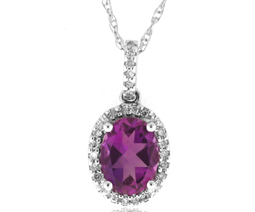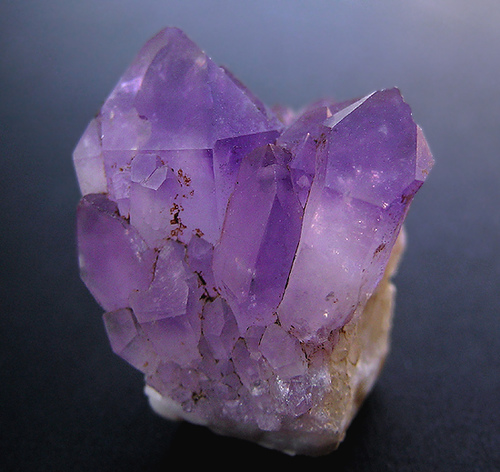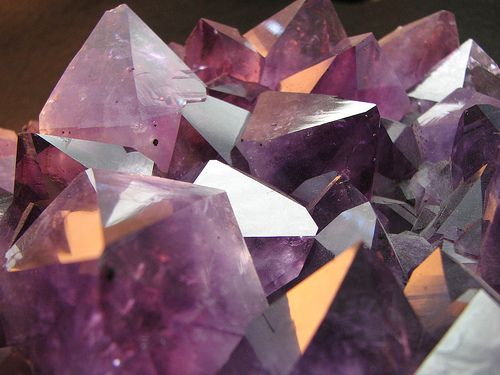Amethyst is an extraordinarily beautiful purple gemstone. For many thousands of years, the most striking representative of the quartz family, amethyst has been a jewel coveted by kings, princes and religious leaders. Designers celebrate amethyst as the ideal choice for jewelry because of its regal color, variety of sizes and shapes, affordability and wide tonal range from light to dark purple. It is a color that you will also treasure in your own jewels.
Amethyst is a purple variety of quartz, which ranges in color from a light violet to an intense royal purple. Some of the finest amethyst now comes from Africa, but the greatest quantity is produced in South America.
The prices and value of amethyst can vary tremendously, depending on the size and quality of the gemstone.
Why Buy Loose Gemstones Instead of Pre-Set Jewelry?
There are many reasons, but mainly it comes down to value and choice...
When buying your gemstone loose instead of a pre-set stone, you can be sure that you are getting the best value for your money. Loose gemstones are less expensive, a better value, and you can really see what you are paying for. The most important part of getting the right price and finding the best value is to first see what you're getting. A jewelry setting will hide the inclusions inside a gem, and can deepen or brighten its color. With a loose stone you can much more easily inspect the gem and see it for what it really is. In this way you can get a better idea of its true worth and be sure you are paying a fair price.
The second advantage of buying a loose gemstone is choice. You are free to pick the exact color, cut, shape and variety of the stone for the setting of your dreams, be it yellow gold, white gold, platinum or silver; prong set or bezel set with diamond accents. You can experience the joy of creating your very own, one-of-a-kind jewelry design. Choose from a variety of jewelry settings and styles to create a completely original presentation that will perfectly suit your individual gemstone and will be as unique as you are!


| Origin | Brazil, Germany, Hungary, India, Canada, Australia, South America, Iran, Japan, Madagascar, Mexico, Sri Lanka, Africa, U.S.A, USSR. |
|---|---|
| Color | Purple, light purple to intense royal purple mauve and violet, loose amethyst gemstones come in all shades of purple. |
| Refractive Index | 1.544 - 1.553 |
| Chemical Composition | SiO2 |
| Hardness | 7 |
| Density | 2.6 - 2.7 |
| Crystal Structure | Hexagonal |
Amethyst is a macrocrystalline variety of the mineral Quartz (SiO2). Quartz is one of the most abundant single minerals on earth. It makes up about 12% of the earth's crust, occurring in a wide variety of igneous, metamorphic and sedimentary rocks.
Quartz varieties are commonly separated into two groups based on the size of the individual grains or crystals; macrocrystalline quartz in which individual crystals are distinguishable with the naked eye, and cryptocrystalline quartz in which the individual crystals are too small to be easily distinguishable under the light microscope.
Some of the macrocrystalline quartz varieties are: Amethyst, Ametrine, Cat's-eye Quartz, Citrine, Phantom Quartz , Rock Crystal, Rose Quartz, Rutilated Quartz and Smoky Quartz. Blue Aventurine Quartz and Green Aventurine Quartz are actually quartzites (a rock, not a mineral) composed essentially of interlocking macrocrystalline quartz grains with disseminated grains of other color imparting minerals.
The cryptocrystalline varieties of quartz may be separated into two types; fibrous and microgranular. Chalcedony is the general term applied to the fibrous cryptocrystalline varieties. Agate is an example of a fibrous cryptocystalline banded chalcedony variety of quartz. Carnelian, Chrysoprase and bloodstone are other chalcedony varieties. Chert is the general term applied to the granular cryptocrystalline varieties of quartz, of which flint and Jasper are examples.


The purple color of amethyst is due to small amounts (approximately 40 parts per million) of iron (Fe4+) impurities at specific sites in the crystal structure of quartz. The difference between amethyst and citrine is only the oxidation state of the iron impurities present in the quartz. Upon heating, the iron impurities are reduced and amethyst's purple color fades and becomes yellow to reddish-orange (citrine), green, or colorless depending on the site and original oxidation state of the iron impurities present and the amount and duration of the heating. The amethystine color usually can be regained by irradiation which re-oxidizes the iron impurities. This irradiation can be done by synthetic means, or it can occur in nature by radioactive decay of nearby radioactive minerals. In most cases this is a reversible process, however excessive heating may change the distribution of the iron impurities at the different sites within the quartz making it impossible to convert it back to amethyst by subsequent irradiation. The heating process can occur naturally or synthetically.
Amethyst has a chemical formula of SiO2, a density of 2.60 - 2.70, and a refractive index of 1.544 - 1.553. The refractive index (RI), measured using a refractometer, is an indication of the amount light rays are bent by a mineral. Birefringence is the difference between the minimum and maximum RI. When birefringence is high, light rays reflect off different parts of the back of a stone causing an apparent doubling of the back facets when viewed through the front facet.
Most gems have a crystalline structure. Crystals have planes of symmetry and are divided into seven symmetry systems. The number of axes, their length, and their angle to each other determine the system to which a crystal belongs. Amethyst gemstones belong to the Hexagonal crystal system. Amethyst is composed of an irregular superposition of alternate lamellae of right-handed and left-handed quartz. It has been shown that this structure may be due to mechanical stresses. As a consequence of this composite formation, amethyst is apt to break with a rippled fracture or to show "thumb markings", and the intersection of two sets of curved ripples may produce on the fractured surface a pattern something like that of "engine turning".
More recent work has shown that amethyst's coloration is due to ferric iron impurities. Further study has shown a complex interplay of iron and aluminium is responsible for the color.
Amethyst is mined in Brazil, Uruguay, Bolivia, Argentina, India, North America and some African countries. Generally, amethyst from South America tends to be available in larger sizes than African amethyst but amethyst from Africa has the reputation for having better, more saturated, color in small sizes. Very dark amethyst, mostly in small sizes, is also mined in Australia.
However, the amethyst is more likely to turn up in spaces lining agate almonds and druses in igneous rocks. What was presumed to be the largest-ever cavity was discovered in 1900 in Rio Grande do Sul. The almond measured ten by five by three meters (33 by 16 by 10 ft.) and weighed an estimated eight tons. The dark violet amethysts, some as large as a man's fist, may have weighed some 700 cwt. altogether. There is a piece weighing 200 kilograms, taken from this Brazilian treasure, in the Washington Museum. In recent times, a find in the USA has been making headlines. In July 1993, a three-meter druse was found in Maine, which contained well over 1000 kilograms of cuttable amethyst, some of it in crystals 19 cm in length.
A large number of further miraculous powers are attributed to amethyst gemstones in all sorts of cultures.
The name amethyst comes from the Greek a ("not") and methuskein ("to intoxicate"), a reference to the belief that the stone protected its owner from drunkenness; the ancient Greeks and Romans wore amethyst gems and made drinking vessels of it in the belief that it would prevent intoxication.
The legend of the origin of amethyst comes from Greek myths. Dionysius, the god of intoxication, was angered one day by an insult from a mere mortal and swore revenge on the next mortal that crossed his path, creating fierce tigers to carry out his wish. Along came unsuspecting Amethyst, a beautiful young maiden on her way to pay tribute to the goddess Diana. Diana turned Amethyst into a statue of pure crystalline quartz to protect her from the brutal claws. Dionysius wept tears of wine in remorse for his action at the sight of the beautiful statue. The god's tears stained the quartz purple, creating the gem we know today.
Amethyst's color is as unique as it is seductive, in fact is this gemstone is said, to protect its wearer against seduction.
Amethyst is said to bring serenity and calm, to enhance one's ability to assimilate new ideas, and to assist during meditation. It is also said to give strength and mental stability, and to provide balance between one's physical, emotional, intellectual states. Amethyst is also said to make one shrewd in business matters.


